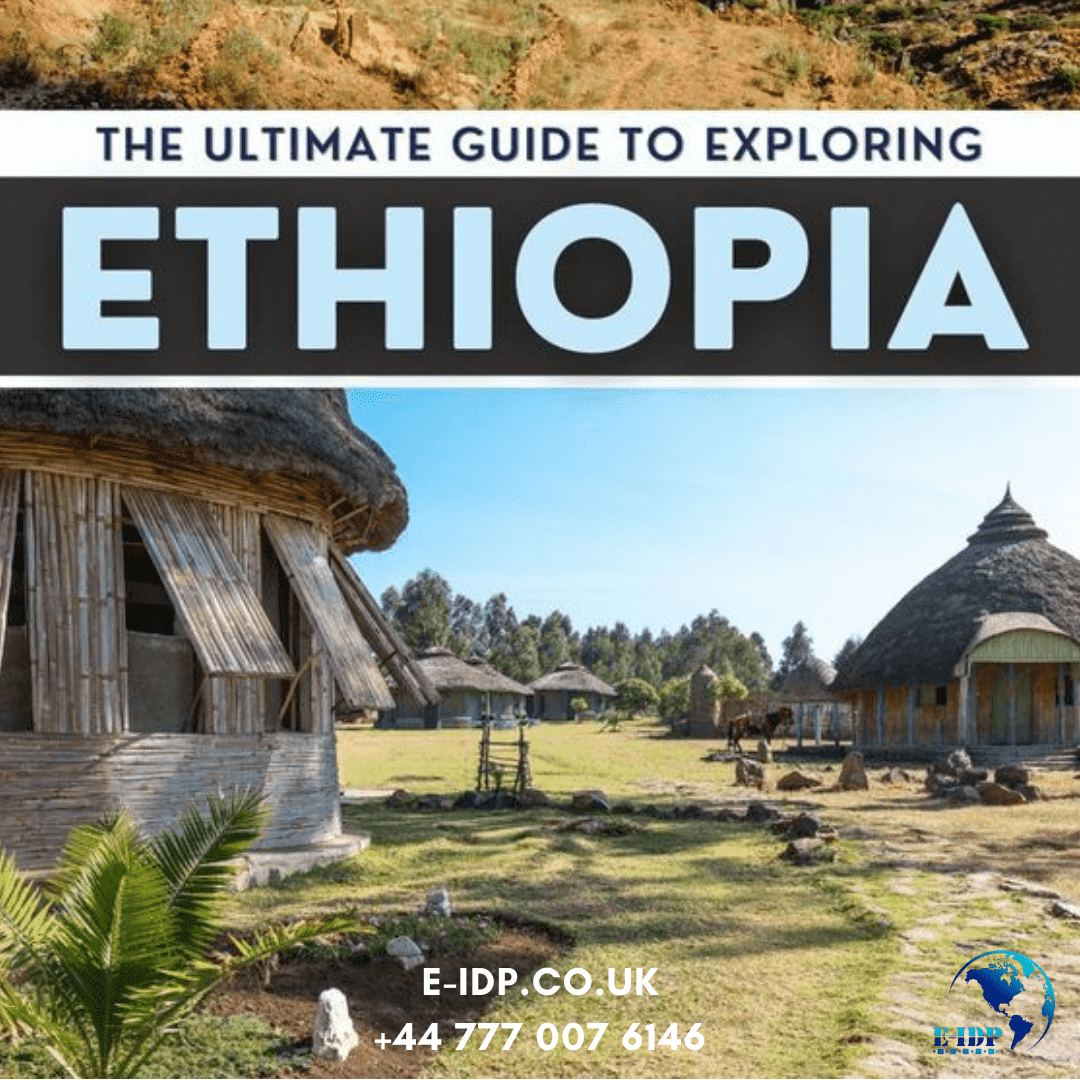Ethiopia Travel guide, IDP apply online Ethiopia, International Driving Permit Ethiopia, International Driving licence Ethiopia, International Driving license Ethiopia
Ethiopia Travel Guide
Ethiopia is a country of extraordinary beauty, rich history, and diverse culture, offering travelers a unique experience unlike anywhere else in the world. Often referred to as the “Cradle of Humanity”, Ethiopia boasts ancient historical landmarks, breathtaking natural scenery, and a fascinating mix of ethnic traditions. This comprehensive Ethiopia travel guide will take you through the best attractions, travel tips, and cultural insights to make your visit to this East African gem truly unforgettable.
Ethiopia Visit?
Ethiopia is a destination that caters to a wide range of interests, from history enthusiasts to adventure seekers. Its long history, unique traditions, and spectacular landscapes make it a must-visit. Highlights include:
- Historical Significance: Ethiopia is home to some of the world’s oldest civilizations, with historical sites that date back thousands of years.
- Natural Wonders: From the rugged peaks of the Simien Mountains to the ancient salt flats of the Danakil Depression, Ethiopia’s geography is incredibly varied.
- Unique Culture: Ethiopia is the only African country never to be colonized, which has helped preserve its rich cultural heritage, language, and traditions.
- Wildlife: Ethiopia’s diverse landscapes are home to endemic species like the Gelada baboon and the Ethiopian wolf.
Top Amusements in Ethiopia
1. Lalibela: The Rock-Hewn Churches
One of Ethiopia’s most iconic destinations, Lalibela is known for its remarkable rock-hewn churches that were carved from solid rock in the 12th century. These UNESCO World Heritage sites are a marvel of ancient architecture and engineering. Lalibela is a sacred pilgrimage site for Ethiopian Orthodox Christians, and visitors are often struck by the spirituality and devotion that surround these ancient places of worship. The most famous of the churches is Bete Giyorgis (St. George’s Church), carved in the shape of a cross.
2. Addis Ababa: The Capital City
Ethiopia’s bustling capital, Addis Ababa, is often the first stop for visitors. This vibrant city offers a mix of modernity and tradition. Be sure to visit the National Museum of Ethiopia, which houses the famous fossilized remains of Lucy, one of the earliest human ancestors. Merkato, Africa’s largest open-air market, is another must-see, where you can experience the chaotic energy of everyday Ethiopian life and shop for local goods.
3. The Simien Mountains National Park
For nature lovers and hikers, the Simien Mountains provide an unforgettable experience. This UNESCO-listed national park is known for its dramatic landscapes of jagged peaks, deep valleys, and cliffs. The Simien Mountains are also home to rare wildlife, including the Walia ibex, the Gelada baboon, and the elusive Ethiopian wolf. Treks range from moderate day hikes to multi-day adventures, offering stunning views and encounters with Ethiopia’s natural beauty.
4. Axum: The Ancient Kingdom
The ancient city of Axum was once the heart of one of Africa’s greatest civilizations, the Aksumite Empire. Axum is steeped in history, with towering stelae (granite obelisks) marking the burial sites of ancient kings. It is also believed to be the final resting place of the Ark of the Covenant, housed in the Church of St. Mary of Zion. Axum’s historical significance makes it an essential stop for any history buff.
5. Danakil Depression
One of the hottest and most inhospitable places on Earth, the Danakil Depression is a surreal, otherworldly landscape of salt flats, active volcanoes, and colorful sulfur springs. The Erta Ale volcano and the salt mines at Dallol are particularly fascinating sights. While the climate can be extreme, the Danakil Depression offers adventurous travelers a truly unique experience that feels like stepping onto another planet.
6. The Omo Valley
The Omo Valley in southern Ethiopia is a cultural hotspot, home to several distinct indigenous tribes, including the Hamar, Mursi, and Karo peoples. Visitors can immerse themselves in the vibrant traditions, ceremonies, and daily life of these tribes, which have remained largely untouched by modernity. The Omo Valley offers an unparalleled opportunity for cultural exploration and photography.
Ethiopia, time to visit
Ethiopia’s climate is varied due to its diverse geography, but generally, the best time to visit is during the dry season from October to March. During these months, the weather is mild, and it’s easier to travel between regions without the interruption of rain.
- October to March: Ideal for visiting historical sites and national parks. This is the best time for trekking in the Simien and Bale Mountains.
- April to September: The rainy season, especially between June and August, can make travel difficult in some areas. However, it’s a great time to witness the lush landscapes, especially in the highlands.
Culture and Etiquette of Ethiopians
Ethiopia’s culture is as diverse as its landscapes, with over 80 ethnic groups and a wide range of languages, traditions, and religious practices. Here are a few cultural tips to keep in mind:
- Religion: Ethiopia is predominantly Christian, with the Ethiopian Orthodox Church being the largest religious group. There is also a significant Muslim population, especially in the east and south. Respect local customs, especially during religious festivals.
- Coffee Ceremony: Coffee plays an integral role in Ethiopian culture, and the traditional coffee ceremony is a sign of hospitality. If invited to a ceremony, it’s polite to stay for at least three rounds of coffee.
- Dining: Ethiopian meals are usually eaten with the hands, using injera (a sour flatbread) to scoop up food. Be mindful of the right-hand rule—only use your right hand for eating and giving or receiving items, as the left hand is considered unclean.
- Greetings: Ethiopians often greet each other with a handshake or, among close friends, by touching cheeks three times. It’s common to ask about someone’s well-being before jumping into conversation.
Travel Guide for Ethiopia
1. Currency and Payment
The official currency of Ethiopia is the Ethiopian birr (ETB). While major cities like Addis Ababa have ATMs and accept credit cards at larger hotels and restaurants, cash is king in more rural areas. Make sure to carry sufficient cash, especially if you’re traveling outside the capital.
2. Language
The official language is Amharic, but there are over 80 languages spoken across Ethiopia. English is widely spoken in urban areas, especially in tourist services, so communication shouldn’t be a problem.
3. Transportation
Getting around Ethiopia can be challenging due to the country’s size and the condition of some roads. Domestic flights between cities like Addis Ababa, Lalibela, and Axum are the most efficient way to travel long distances. For shorter distances, buses and minibusses are common, but they may not always follow strict schedules.
4. Safety
Ethiopia is generally safe for tourists, though it’s always wise to stay updated on local travel advisories, especially in border regions. Petty crime such as pickpocketing can occur in crowded areas, so keep your valuables secure.
5. Health Precautions
Be sure to have updated vaccinations, and consider taking antimalarial medication if you are traveling to lower altitude areas where malaria is present. It’s also recommended to drink bottled or boiled water to avoid waterborne illnesses.
Food in Ethiopia
Ethiopian cuisine is a unique experience that is largely plant-based but also includes a variety of meat dishes. Meals are centered around injera, a spongy flatbread made from teff, which is used to scoop up stews and vegetables. Some must-try Ethiopian dishes include:
- Doro Wat: A spicy chicken stew, often served with hard-boiled eggs, and one of Ethiopia’s most famous dishes.
- Tibs: Stir-fried meat (usually beef or lamb) with onions, garlic, and spices.
- Kitfo: A dish of raw minced beef seasoned with chili powder and herbs. It’s often eaten with kocho (a flatbread made from false banana).
- Shiro: A thick stew made from ground chickpeas or broad beans, flavored with garlic, ginger, and spices, often eaten during fasting periods.
Sumup
Ethiopia is a land of contrasts, offering an unforgettable journey through history, culture, and nature. Whether you are exploring the ancient churches of Lalibela, trekking through the Simien Mountains, or experiencing the traditions of the Omo Valley tribes, Ethiopia has something to offer every traveler. Its unique charm and deep cultural heritage make it a top destination in Africa for those looking to explore beyond the typical tourist trails.
What you need to rent a car, and how to rent one
As a tourist, you’ll most likely be renting a car (more on that in a bit) for your road trip. Even so, there are certain requirements that you’ll have to check off before you get into it.
- You have to get an International Driver’s Permit. Apply for it online or head to the office — we prefer doing it in person because the queue is pretty short during off-peak hours, and you can get it done on the same day. It’ll cost S$20 and is valid for one year from the date of issue.
- A valid local driver’s license. international driving licence online
- You have to be at least 21 years of age and have held your local licence for a year. A surcharge may be imposed for drivers under the age of 25.
- A passport for identification .
- A credit card in the driver’s name.
How to obtain an international driving permit

The process of obtaining an international driving license directly from an office can be quite challenging and time-consuming. The payment methods involved can also be complex. Therefore, it is recommended to consider applying for an international driving license from IMTA. The application process only takes around 10 to 15 minutes, making it a more efficient option for getting your international driving permit Get Your Online Int’l Driving Permit for the United Kingdom
The necessary details required for the application of an International driving permit include:
– Full Name
– Email & Phone Number
– Current Address
– Place of Birth
– National Driver’s License Number
– National Driver’s License Issued Date & Expiry Date
– Picture of Driver’s License & Your Head Shot Photo for Your IDP
Ethiopia Travel guide, IDP apply online Ethiopia, International Driving Permit Ethiopia, International Driving licence Ethiopia, International Driving license Ethiopia, Ethiopia Travel guide, IDP apply online Ethiopia, International Driving Permit Ethiopia, International Driving licence Ethiopia, International Driving license Ethiopia, Ethiopia Travel guide, IDP apply online Ethiopia, International Driving Permit Ethiopia, International Driving licence Ethiopia, International Driving license Ethiopia, Ethiopia Travel guide, IDP apply online Ethiopia, International Driving Permit Ethiopia, International Driving licence Ethiopia, International Driving license Ethiopia






